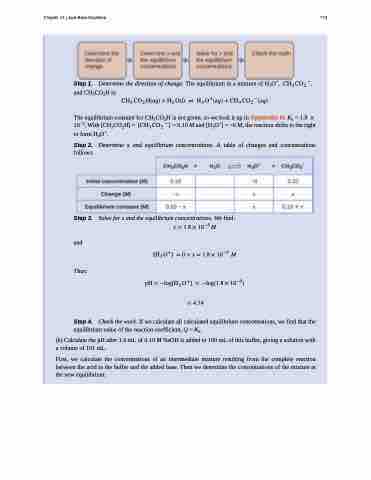Page 783 - Chemistry--atom first
P. 783
Chapter 14 | Acid-Base Equilibria 773
Step 1. Determine the direction of change. The equilibrium in a mixture of H3O+, ��� ��� �� and CH3CO2H is: � �
������������������ � ��� ����������� ����
The equilibrium constant for CH3CO2H is not given, so we look it up in Appendix H: Ka = 1.8 � 10−5. With [CH3CO2H] = ���� ��� �� = 0.10 M and [H3O+] = ~0 M, the reaction shifts to the right to form H3O+.
Step 2. Determine x and equilibrium concentrations. A table of changes and concentrations follows:
Solve for x and the equilibrium concentrations. We find: � � ��� � ���� �
Step 3.
and
Thus:
Check the work. If we calculate all calculated equilibrium concentrations, we find that the equilibrium value of the reaction coefficient, Q = Ka.
(b) Calculate the pH after 1.0 mL of 0.10 M NaOH is added to 100 mL of this buffer, giving a solution with a volume of 101 mL.
First, we calculate the concentrations of an intermediate mixture resulting from the complete reaction between the acid in the buffer and the added base. Then we determine the concentrations of the mixture at the new equilibrium:
Step 4.
������ ������������� � �� � ������� ��� � �������� � �����
� ����


